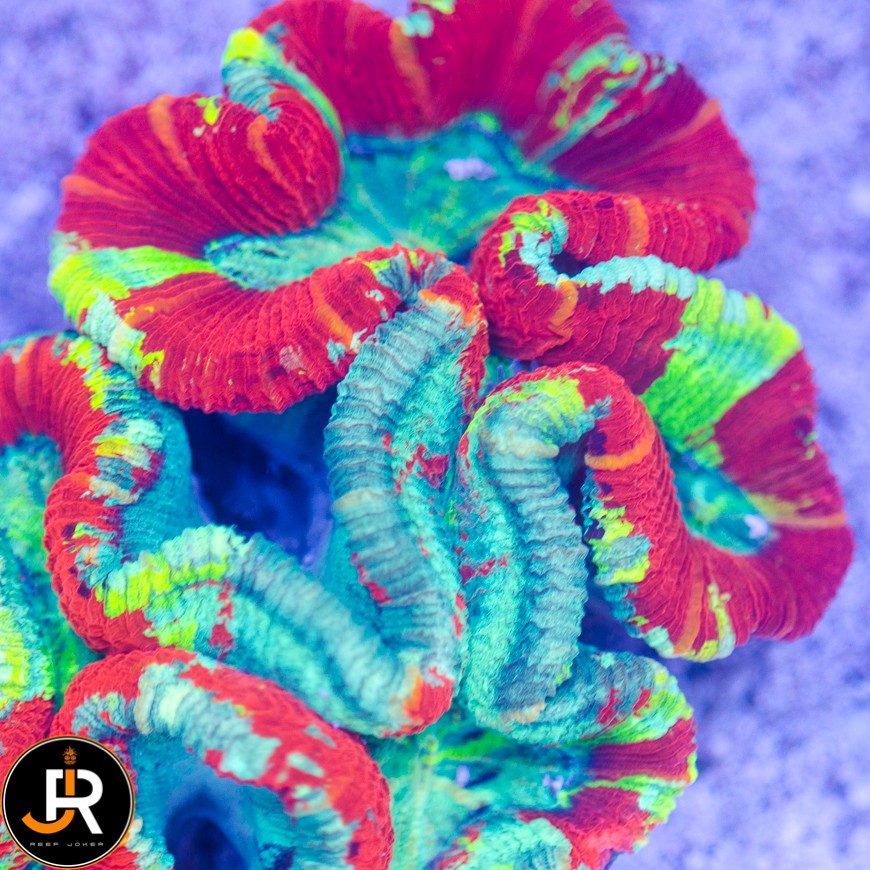

GENERAL NOTIONS ABOUT THE SPECIES
The Trachyphylllie Geoffroyi are among the most particular and famous LPS Corals.
For some years now the market has been offering beautiful Australian varieties, fished off Queensland.
Trachyphyllie are very brightly colored corals, ranging from yellow, green, orange, pink, red to the most colorful combinations of colors.
In Nature these corals are often found solitary, along the base of the Coral Reef, on muddy or sandy bottoms.


This species is described as a free-living 'secondary' coral, because when young, like most other corals, they are attached to something solid (e.g. rocks or shells), but as they grow they become heavier until detach, becoming free living polyps with a cone bottom that helps them to anchor themselves in environments with a soft bottom.
They are voracious eaters and if not fed well they can begin to recede. The octopus's tentacles come out at night to feed and can escape during the day when food is present.


ACCLIMATION IN AQUARIUM
The Australian variant of Queensland of these Trachyphyllie are animals as beautiful as they are delicate especially in the first phase of acclimatization to the tank.
They are animals that in nature live at considerable depths compared to a column of water that an aquarium can guarantee, so proper acclimatization to the tank is essential, in particular as regards the light, because especially if stressed by travel or changes of tub (exporter-importer-shop-hobbyist), are likely to "pull" very easily.
The light factor as mentioned is fundamental for these animals, too many PAR, or too much light power (thinking about our ceiling lights), are deleterious especially in the acclimatization phase.
For too much light, too many PAR is defined (measure of the energy actually available for photosynthesis), so not only whites, as many aquarists often understand, these animals can also suffer under other color channels, pushed to too high powers. , starting and clearing, losing the zooxanthellae and gradually reducing the tissue, until death, this phenomenon is normally called BLEACHING.


PERSONAL EXPERIENCE
It has now been about 4 years that as Reef Joker I buy and sell these splendid Trachyphyllie, at the beginning it was really difficult to understand how to move with these animals, which are also different, significantly different, as needs in the acclimatization phase of those of the same species coming from other areas both of Australia (e.g. those of the west coast, and northern territory or the Cairns area), and from other areas of the world.
The Trachyphyllie do well in oily water, with, especially at the beginning, a low power of light, provided if possible not direct.
I noticed a greater extroversion with temperatures around 24 °, but they also hold up well at temperatures up to 26 °, as far as movement is concerned, however, especially in the capture / feeding phase, they do not disdain turbulence in the water.
Having very low in-store tanks, 30cm high and without any crevice or natural shelter, despite keeping my Radion G4 at about 1m in height from the pool edge, I have noticed that the best solution as soon as they arrive is to bring the general power of the Radion G4 to 35%, and then gradually raise it over time (months) until it returns to its original power (60%).
As for the feeding over time I have found that, at least in my tanks, they react better, and do not go into stress, not with a direct feeding (as is thought for many LPS with mouth quite similar like Lobophyllie or Scolymie), but with an indirect feeding, therefore often in the evening or at night I feed them by dosing zooplankton in the tank, letting them capture the food alone, and no longer directly on the mouths with powdered feed, granular for lps or pieces of shrimp, thus making the animals react much better, and they tend to always remain open and everted.


CONCLUSIONS
As mentioned, the Trachyphyllie are animals as beautiful as they are difficult, especially in the acclimatization phase, so the advice I would like to give is to try to set them in the best possible way in your tank, considering their light needs as primary.


